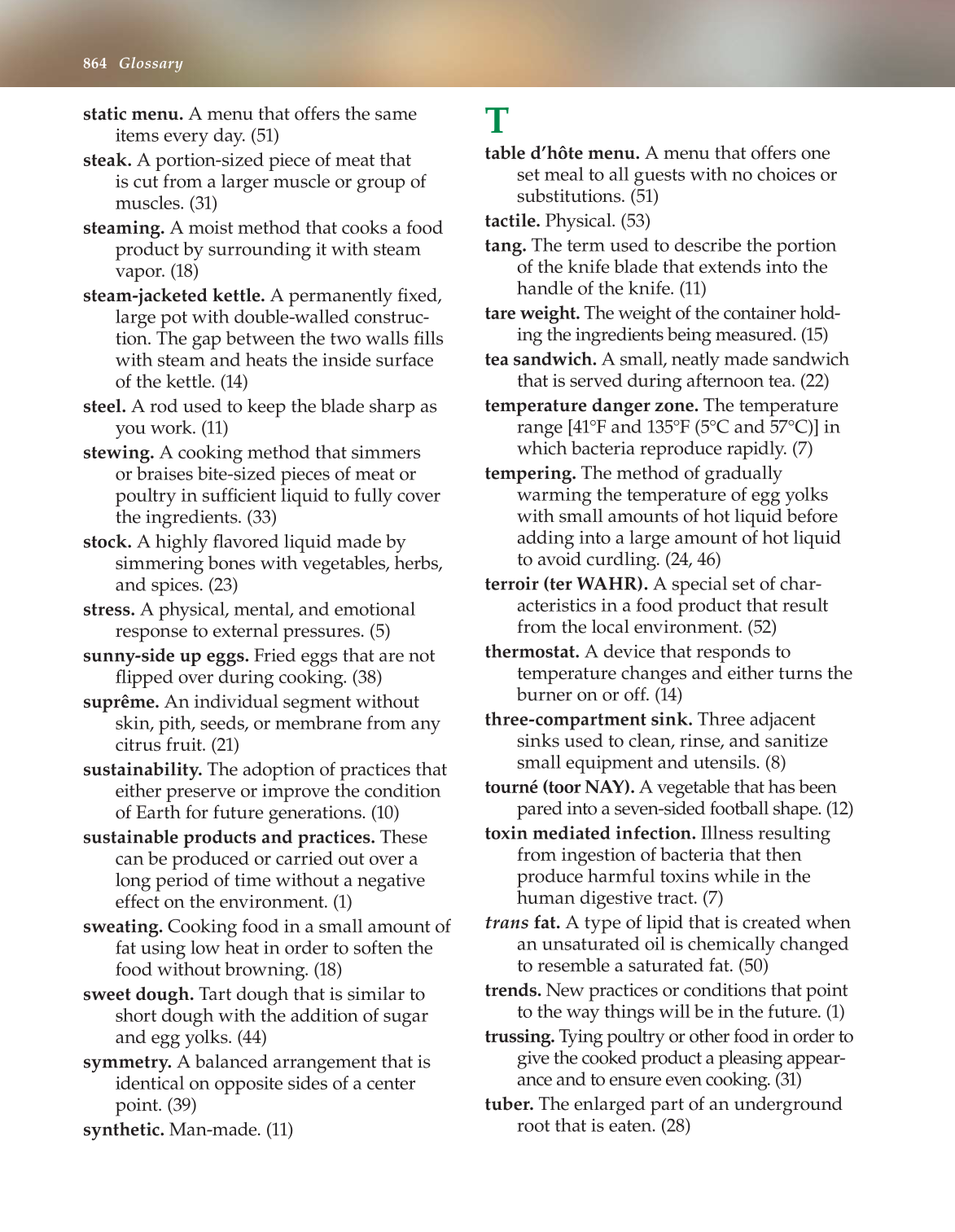864 Glossary
static menu. A menu that offers the same
items every day. (51)
steak. A portion-sized piece of meat that
is cut from a larger muscle or group of
muscles. (31)
steaming. A moist method that cooks a food
product by surrounding it with steam
vapor. (18)
steam-jacketed kettle. A permanently fi xed,
large pot with double-walled construc-
tion. The gap between the two walls fi lls
with steam and heats the inside surface
of the kettle. (14)
steel. A rod used to keep the blade sharp as
you work. (11)
stewing. A cooking method that simmers
or braises bite-sized pieces of meat or
poultry in suffi cient liquid to fully cover
the ingredients. (33)
stock. A highly fl avored liquid made by
simmering bones with vegetables, herbs,
and spices. (23)
stress. A physical, mental, and emotional
response to external pressures. (5)
sunny-side up eggs. Fried eggs that are not
fl ipped over during cooking. (38)
suprême. An individual segment without
skin, pith, seeds, or membrane from any
citrus fruit. (21)
sustainability. The adoption of practices that
either preserve or improve the condition
of Earth for future generations. (10)
sustainable products and practices. These
can be produced or carried out over a
long period of time without a negative
effect on the environment. (1)
sweating. Cooking food in a small amount of
fat using low heat in order to soften the
food without browning. (18)
sweet dough. Tart dough that is similar to
short dough with the addition of sugar
and egg yolks. (44)
symmetry. A balanced arrangement that is
identical on opposite sides of a center
point. (39)
synthetic. Man-made. (11)
T
table d’hôte menu. A menu that offers one
set meal to all guests with no choices or
substitutions. (51)
tactile. Physical. (53)
tang. The term used to describe the portion
of the knife blade that extends into the
handle of the knife. (11)
tare weight. The weight of the container hold-
ing the ingredients being measured. (15)
tea sandwich. A small, neatly made sandwich
that is served during afternoon tea. (22)
temperature danger zone. The temperature
range [41°F and 135°F (5°C and 57°C)] in
which bacteria reproduce rapidly. (7)
tempering. The method of gradually
warming the temperature of egg yolks
with small amounts of hot liquid before
adding into a large amount of hot liquid
to avoid curdling. (24, 46)
terroir (ter WAHR). A special set of char-
acteristics in a food product that result
from the local environment. (52)
thermostat. A device that responds to
temperature changes and either turns the
burner on or off. (14)
three-compartment sink. Three adjacent
sinks used to clean, rinse, and sanitize
small equipment and utensils. (8)
tourné (toor NAY). A vegetable that has been
pared into a seven-sided football shape. (12)
toxin mediated infection. Illness resulting
from ingestion of bacteria that then
produce harmful toxins while in the
human digestive tract. (7)
trans fat. A type of lipid that is created when
an unsaturated oil is chemically changed
to resemble a saturated fat. (50)
trends. New practices or conditions that point
to the way things will be in the future. (1)
trussing. Tying poultry or other food in order to
give the cooked product a pleasing appear-
ance and to ensure even cooking. (31)
tuber. The enlarged part of an underground
root that is eaten. (28)
